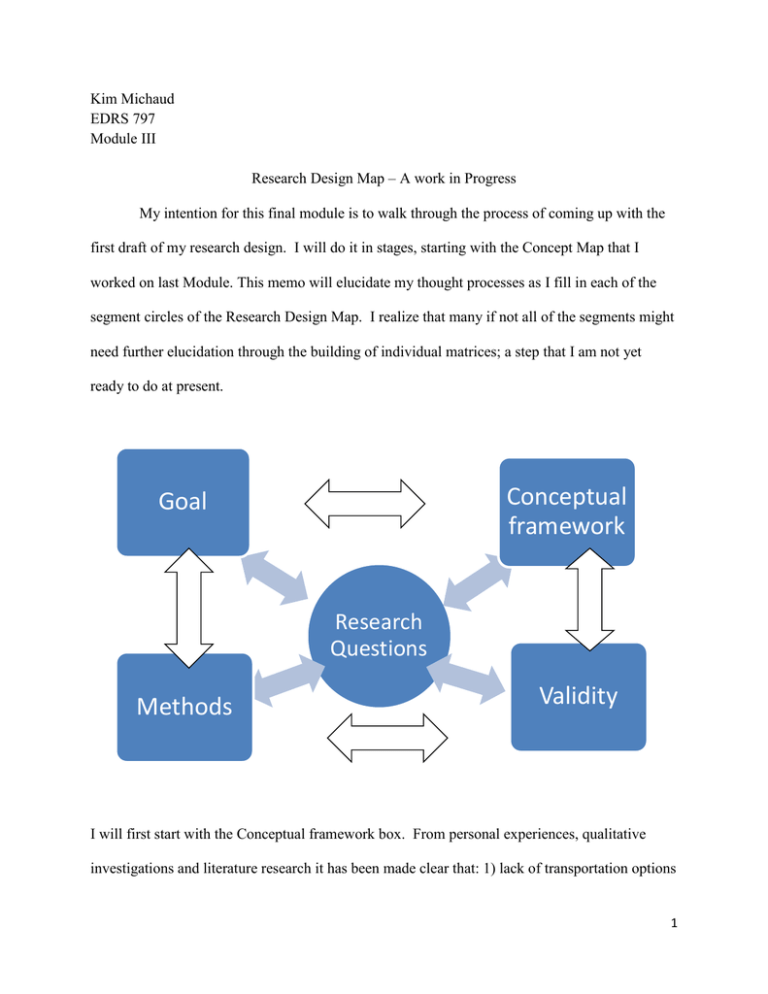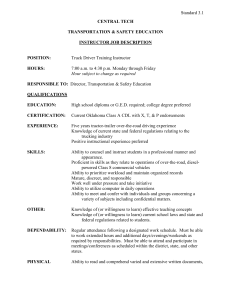Research Design Map
advertisement

Kim Michaud EDRS 797 Module III Research Design Map – A work in Progress My intention for this final module is to walk through the process of coming up with the first draft of my research design. I will do it in stages, starting with the Concept Map that I worked on last Module. This memo will elucidate my thought processes as I fill in each of the segment circles of the Research Design Map. I realize that many if not all of the segments might need further elucidation through the building of individual matrices; a step that I am not yet ready to do at present. Conceptual framework Goal Research Questions Methods Validity I will first start with the Conceptual framework box. From personal experiences, qualitative investigations and literature research it has been made clear that: 1) lack of transportation options 1 limit education, employment, and independence; 2) In general,in places with limited public transportation, and limited alternative transportation services, the ability to drive a car is essential for continued education, employment and independence; specifically, this is a serious problem in West Virginia; 3) those with mild to moderate intellectual disabilities often have difficulty passing the written portion of the driver’s exam, but at least one study has indicated that these individuals can be trained to safely drive in at least daylight, good weather conditions. What is unclear from my research at present: how many in this population are unable to pass the written and/or practical driver’ exam: many, most? If further concrete statistics are not available, this indeed could become my 1st research question: What portion of individuals from this demographic have not been successful obtaining driver’s licenses? Percentage of this population as a whole, or of those who would need licenses, or of those who have attempted to get them? (because of resource barriers and time limitations, I might have to limit this to WV) I don’t think exact figures are critical here; what you want to show is that there are a significant number who need licenses to work, but who have been unable to pass the exam. I’m not sure this should be an explicit research question that your study will attempt to answer; it seems much more like background information for you to make the case that your study addresses an important issue; 4) 39 states have made accommodations for low vision individuals who can use bioptics to obtain restricted or unrestricted licenses based on going studies which have indicated they could effectively become safe drivers according to established safety criterions What is unclear from my research at present: what are the unique safety criterions that must be addressed for the mild to moderate ID population? This indeed could become my 2nd research question: What are the unique safety criterions that must be addressed for the mild to moderate population? Again, I’m not sure that this 2 should be a research question, for the same reasons. 5) I have interviewed a former Voc Rehab driver instructor who has opened up his own school and specializes in evaluating, and preparing individuals with a wide spectrum of disabilities to obtain driver’s licenses. He has developed unique strategies to prepare for both written and on the road exams, and has worked with the local DMV to also provide additional accommodations when needed. What is unclear from my research at present: How many individuals in the mild to moderate ID population has he evaluated and instructed? If he has evaluated and instructed individuals in this population have they successfully obtained licenses, and remained safe drivers? What were their previous experiences with this process? If they were not successful, or could not pass his safety criterion would they be able to under restricted conditions? This can lead to my 3rd research question: Are there strategies for training and evaluating this population that can successfully prepare them to be safe drivers at least under restricted conditions? This is a yes/no question; your main research question (particularly in a qualitative study) should be more open—for example, How successful has this instructor been in preparing these individuals to obtain driver’s licenses and to be safe drivers under restricted conditions, and how has he done this? From my first question At this juncture I can fill in three of the segments based upon my first draft musings and reflections: Conceptual framework, Research Questions, and Goals. 3 Conceptual Framework: lack of transportation options limit education, employment, and independence In general, in places with limited public transportation, and limited alternative transportation services, the ability to drive a car is essential for continued education, employment and independence; specifically, this is a serious problem in West Virginia those with mild to moderate intellectual disabilities often have difficulty passing the written portion of the driver’s exam, but at least one study has indicated that these individuals can be trained to safely drive in at least daylight, good weather conditions safety criterion established by experts validated by experiential statistics ?? can be used to provide unique accommodations, preparation and options to overcome barriers to obtaining driver’ s licenses with at least restrictions A disability driving specialist could provide has provided? criterion standards, preparation and evaluation strategies, that would be are? appropriate for the mild to mod. ID population Research Questions 1. What portion of individuals from this demographic who are clients of WV Voc. Rehab have not been successful obtaining driver’s licenses? 2. What are the unique safety criterions that must be addressed for the mild to moderate population? 3. Are there strategies for training and evaluating this population that can successfully prepare them to be safe drivers at least under restricted conditions? 4 I will take the goal from the 1st question that was indicated from my Concept map. The other questions may or may not be included within the goal (s) depending on the refining of the research. Goal Discover if there are possibilities for overcoming barriers to obtaining driving privileges for individuals with mild to moderate ID in WV. Good, but could be even broader: “establish ways for these individuals to obtain driver’s licenses and drive safely under restricted conditions.” I am now ready to come up with ideas for the methods I might use in order to answer my research questions. For Question # 1, I will collect demographic characteristics on clients of this instructor? of Voc Rehab? and whether they have obtained driver’s licenses, or if they have attempted to do so based on the records kept on clients by Vocational Rehabilitation Field Officers throughout WV, I have already gotten permission from the director of the Ohio County Office to do so in her office. After speaking to one field officer previously, I learned that driver license information was not necessarily kept in clients files. I might have to come up with a simple questionnaire with some kind of reward system to either have field officers obtain this information from clients, through mail or phone, or allow me to obtain this information from clients by mail or phone. As I suggested above, I don’t think this needs to be a research question. 5 For this I would need to get clearance from the WV director of Vocational Rehabilitation. So the first method used will be data gathering through records and /or questionnaires to be analyzed by quantitative descriptive analysis. The second question will be answered via conducting a case study on the specialized driver instructor. Through interviews, observations, and gathering of resource materials that he uses, I will be able to ascertain what particular safety concerns he is aware of that are peculiar to this population, and how what methods he uses to assist individuals to reach appropriate safety criterion levels, and how those are evaluated. The second method that I will use will be to conduct a case study on the specialized driver instructor. Although I think that this could be a subquestion of my broader main research question. Question #3 will be answered through the cases study of the specialized driver instructor, as well as interviews with clients that he has had who fall into this populations’ demographics. I will question them about their experiences with their attempts to obtain a driver’s license, and their experience with the strategies and preparations that this instructor provided. The third method I will use, therefore, will be interviews with the instructors’ previous and/or present clients that are representative of the mild to moderate ID population, and with the instructor. Methods quantitative data through records & questionnaires of WV Voc Rehab clients representative of this population case study of driver instructor interviews and or observations with past and/or present clients 6 The last section to be complete is the validity. This is the most difficult for me at this juncture, since so much of this design map is in progress. I will list the first threats that come to mind, with the understanding that this will definitely need additional refinement as I proceed. 1. researcher bias: this one is particularly crucial since not only will I be the only one conducting the interviews and observations, but I am intimately involved in with this subject since my daughter belongs to this population, and is undergoing this challenge. It might be beneficial for me to conduct aspects of a self-study, so that I can best indicate where by biases might lie, thereby making my data gathering and analysis more transparent. I think you already done some of this, and that the main strategy is to continually be self-critical of your work, being alert for ways in which you may be slanting your data collection or analysis to fit your biases. I most certainly need to indicate where these biases might be surfacing in the transcripts of questions, and interview questions. It might be helpful (but maybe not realistic) to have an objective observer listen to tapes, and read transcripts for “leading” questions, or voice tones” Certainly you’ll need to have someone else read over your transcripts and your analysis. 2. Inaccuracy of data collected through records/questionnaires via Voc. Rehab. If specific data is not collected for this information, and I must design a system that either busy field officers must implement, or that is confidentially sufficient for me to be allowed conduct the data gathering, the final data my end up being very sketchy and perhaps “cherry picked.” Other than indicating this as a possibility, I see no way of overcoming it. As I said above, I don’t see this as a critical issue. 3. Disclosure bias: The instructor may disclose successes etc. from a biased point of view. True; you have to be the judge of this. The interviews of clients could balance this, if 7 they can be obtained. The safety criterion could be also balanced by other specialists in the field. Good idea. Member checks will be used to validate bias of interviews, observations. OK. Validity researcher bias: self-study and/or transparency with data analysis and conclusions Sampling bias or inaccuracy: disclosure disclosure bias: member check, interview with clients/interview with instructor balance. expert opinion reliability: access other experts if possible Kim: This is a very nice design map and a thoughtful reflection on your plans. I don’t think you need the first research question as a question; I see this as part of what you need in developing your conceptual framework. I really don’t have anything to add to my comments above. Grade for assignment: A Grade for course: A 8
